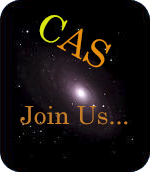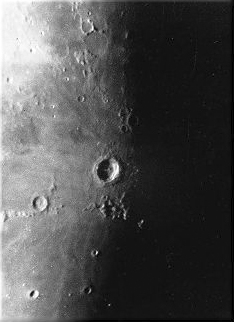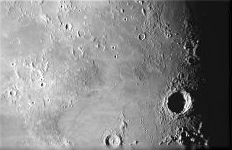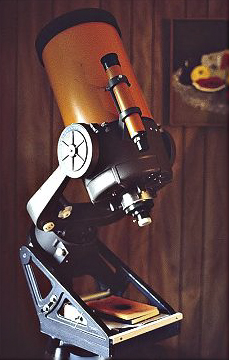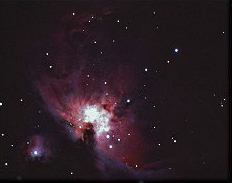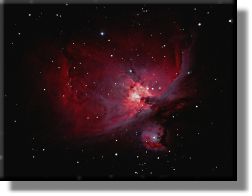Klaus
Yes
A Half Century of Astrophotography
By Klaus Brasch
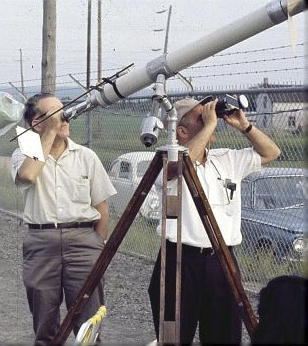 Fig. 1 My late father and a friend observing the 1963 total eclipse of the sun in eastern Quebec, with our 3-inch refractor on its plumber’s nightmare mount.
Fig. 1 My late father and a friend observing the 1963 total eclipse of the sun in eastern Quebec, with our 3-inch refractor on its plumber’s nightmare mount.
Today, as we look at the spectacular images taken with the Hubble Space Telescope, with giant instruments on faraway mountain tops, and indeed by many skilled amateur astronomers, it’s easy to forget how far astrophotography has come over the past 50 years. My venture into the hobby began as a teenager in the late 1950s when I took my first grainy pictures of the Moon with a home-made refractor equipped with a 3-inch f/13 war-surplus lens (Fig. 1).
As to cameras, the few commercial models available were either way beyond my pocket book or totally unsuitable for astronomical photography, as were most films of the day, slow and grainy. None of that stopped me though. My father found an old leaf shutter which we glued to a cheap Bakelite camera and then attached that to the telescope eyepiece holder with a 1.25 inch wide cardboard tube (Fig. 2). Since my telescope had no motor drive, I was limited to snap shots of the Moon using the fastest (and grainiest) film of the day, the legendary Kodak 828 Tri-X.
Then as now, the real challenge was focusing the camera through the telescope. In this pre-digital age, there were no “live view” options, LCD screens, computers or any other focusing aids. Even expensive single lens reflex (SLR) cameras, were a decade away. My only option was to scotch-tape a piece of wax paper to the film plane of the open camera as a makeshift focusing screen. After marking the focus point on the eye piece draw tube, I would remove the camera and wax paper, load the film, and reattach my not-so-high-tech toy to the telescope. Despite the fact that those pictures were as grainy as sand paper (Fig. 3), I was elated with the results.
Sometime later I got access to a really fine 6-inch 19th century brass refractor, the primary instrument of the Montreal Center of the Royal Astronomical Society of Canada. After much trial and error with my home-made camera, I finally obtained an image of the crater Copernicus that was to be my pride and joy for many years (Fig. 4). It looks pretty dismal by to-day’s standards (Fig. 5), but I was overjoyed. When I needed money for college and then graduate school, I sold all my optical equipment and my astrophotography “career” went into prolonged eclipse.
In 1979, however, while on sabbatical leave in California from my faculty position at Queen’s University in Kingston, Ontario, I rediscovered the joys of photographing the heavens. Southern California was astronomy heaven then, with major observatories and leading telescope manufacturers. I had my eyes on one of those sensational new orange tube Celestron 8-inch telescopes, which were both affordable and portable, and ideal for astrophotography. On a visit to Celestron in Torrance, however, I learned that one of their classic C-10 telescopes was for sale. Only 300 of these superb f/13 SCTs were made in the 1960s and mainly intended for lunar and planetary observing. Mine was fully modernized, with coated optics, a solid wedge and tripod, and accurate electric drive (Fig. 6). I also bought an Olympus OM-1, 35-mm SLR camera, favored by many astrophotographers for deep-sky. After getting my first image of the Orion Nebula with the-then “fast” Ektachrome 400 film (Fig. 7), I was hooked for life.
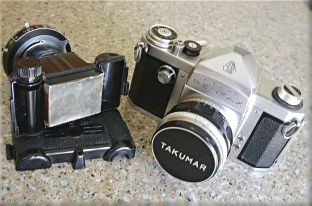 Fig. 2 My home made astro-camera (left) with wax paper focusing screen and leaf shutter. The classic Asahi Pentax SLR was used years later.
Fig. 2 My home made astro-camera (left) with wax paper focusing screen and leaf shutter. The classic Asahi Pentax SLR was used years later.
Film-based astrophotography peaked in the late 1990s thanks to the availability of sensitive color films, light pollution filters and image digitization. My favorites were Ektachrome 200 slide and Fuji chrome Provia color-reversal films, which are still used by some devotees today. Not only are these very fine-grained and red sensitive films suitable for deep sky photography, but by taking several exposures, scanning and digitizing them, it became possible to stack and process them for maximum effect. One of my best film-based images is shown in Fig. 8.
By the late 1990s astronomical CCD cameras were becoming affordable enough that amateurs could acquire them. I held out for a while longer but always told myself that when they come out with a digital SLR that was as good and easy to use as my trusty old Olympus OM-1, I will go over to the dark side. That day came in 2005 with the Canon 20D. “Digital testosterone” they labeled it, with an 8.2 MP CMOS APS sensor and a host of other refinements. My 20D was custom modified for even greater red sensitivity, and the first image I took with it of the Orion nebula showed me that film had at last gone the way of the dinosaurs (and I loved dinosaurs!).
Digital imaging of course required a whole new set of skills that someone nearing retirement like me, was rather apprehensive about. Not only that, but special image stacking software, dark framing and flat fielding, newer (and costlier) versions of Photoshop, expensive narrow band-pass filters, special focusing aids, field flatteners, etc., all contributed to the feeling of techno-panic! Moreover, my treasured Canon 20D was soon superseded by even better models with higher resolution, easier to focus, less internal noise, and, naturally, even costlier. Since this seems to happen at regular intervals with no end in sight, I had clearly been sucked into an astro-imaging black hole!
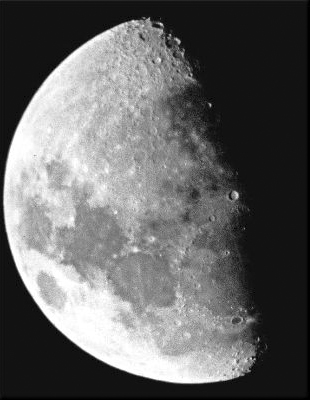
Fig. 3 My first image of the Moon shot in 1959 on Kodak Tri-X film with the modified toy camera and the 3-inch refractor shown above.
In the end though, it’s been well worth it. Never in my wildest dreams half a century ago, did I envision that someday I could capture astronomical images with modest size telescopes that superseded the best film-based photos taken with giant telescopes only a couple of decades earlier. The sky is literally the limit for digital deep-sky imaging. My current modified Canon 6D can be used up to ISO 6400 without significant image noise. In addition to live view focusing, programmable noise reduction and continuous shooting mode, it lists a host of other features. Of course all this will be superseded in a couple of years by even better cameras!
Probably the biggest boom for astronomical imaging are special light pollution and narrow band-pass filters, which are selective for H-alpha, H-beta, O-III and S-II, wavelengths emitted by many deep-sky objects. This has made it possible for amateurs to capture remarkable deep-sky images even from urban and suburban settings. Fortunately for those of us living under the astro-friendly skies of northern Arizona, light pollution is relatively low, especially near Flagstaff “The world’s first dark skies city”. We built a backyard observatory on our property here where I have obtained some of my best celestial images. Many of these can be found in our website Photo Galleries section.
It has been a long but most rewarding journey since I took my first fuzzy pictures of the Moon in 1959. While I thoroughly enjoyed my professional career as university teacher and researcher, astrophotography has been and continues to be a fulfilling and creative outlet in retirement. Astrophotography has always been, as my late friend, great astro-imager and accomplished golfer, Mike Mayerchak, used to say “a lot like golf; you play mainly to best yourself”.
Outreach || Flagstaff || Photos || Articles || Observing Sites || Weather
Coordinated Universal Time || National Weather Service
info@coconinoastro.org

